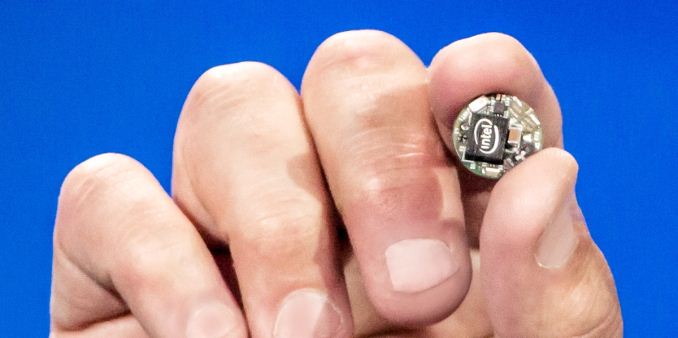Intel Announces Curie: Tiny Module for Wearables
by Stephen Barrett on January 7, 2015 11:31 AM EST
Yesterday, Intel announced a new module targeted to wearable technology: Intel Curie. This module continues Intel's push into IoT and wearable technology started with the Intel Edison. While we thought Edison was small, at just above the size of a US postage stamp, Curie goes even further. Intel has not revealed exact dimensions, but the overall package appears to be the size of a US dime, or small button. The circular PCB shape is also fairly unique and novel. Curie is so small it could theoretically be integrated into rings.
Despite its size, Curie packs in a reasonable amount of functionality. Curie is headlined by a new SoC Intel claims is their first purpose-built for wearables: the Quark SE. Curie was only just announced so we do not have complete specifications yet but I have compiled what is available.
| Intel Curie | Intel Edison Development Platform | |
| CPU | Quark SE @ ? MHz | Dual-Core Silvermont Atom @ 500MHz + Quark @ 100MHz |
| RAM | 80kB SRAM | 1GB LPDDR3 (2x32bit) |
| WiFi / BT | "BT Low Energy" | 2.4/5GHz 802.11a/b/g/n, BT 4.0 |
| Storage | 384kB flash | 4GB eMMC |
| I/O | Battery charging PMIC | SD + UART + SPI + GPIO + USB 2.0 OTG |
| OS | Open source Real-Time OS | Yocto Linux v1.6 (CPU) Open source Real-Time OS (MCU) |
| Dimensions | Approx. US dime (~18mm diameter) |
35.5 x 25 x 3.9 mm |
| Sensors | Integrated DSP sensor hub with pattern matching 6-axis combo sensor (accelerometer and gyroscope) | - |
Intel did not specify if the Bluetooth antenna was built into the PCB or needs to be added on. As Curie integrates sensors and a battery charging PMIC directly whereas Edison provides interfaces to connect to those same features, it is clear Intel designed Curie to be stand alone. Therefore, accounting for the other hardware that needs to be built around Edison, the size difference grows.
Intel's Curie does not include an applications processor and instead relies entirely on the MCU. This may seem limiting compared to powerful Galaxy Gear or Android Wear devices, but there are many devices such as Fitbit and even the Microsoft Band that also exclude an applications processor. This should enable Curie to be exceptional for battery life, however Intel provided no power consumption figures.
Curie will ship in 2H 2015 and be bundled with Intel IQ Software Kits. Intel IQ is a set of algorithms, device software, smartphone apps, and cloud integration (management, analytics, user and company portals) and breaks down into two components: Body IQ and Social IQ with corresponding biometric and connectivity focuses.










23 Comments
View All Comments
frozentundra123456 - Wednesday, January 7, 2015 - link
A device named after a unit of ionizing radiation or a dead scientist. Clever marketing.stephenbrooks - Wednesday, January 7, 2015 - link
I thought it was named after a spicy Indian dish.jhh - Sunday, January 11, 2015 - link
This looks like a competitor to the Broadcom WiCED SENSE and the associated BCM20737 and MEMS sensors.The Broadcom component uses a button battery, which may have driven the circular shape of the Intel component. The Broadcom chip includes the Bluetooth, but the other sensors are on a separate chip. Presumably the other sensors could be added to the Curie. The Broadcom device costs about $20, but no idea if it is being subsidized.